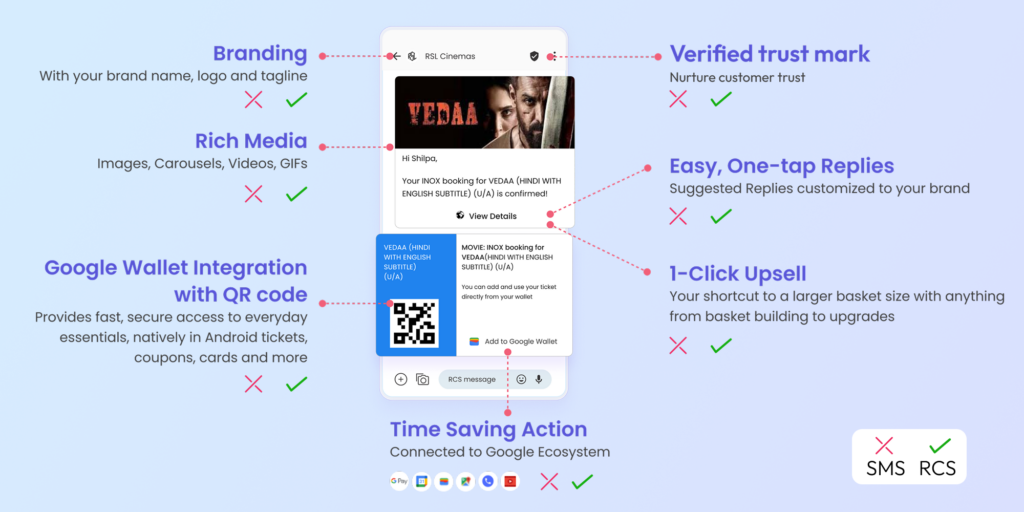Visual messaging isn’t just nice-to-have anymore—it’s essential for connecting with today’s customers. While Multimedia Messaging Service (MMS) has served businesses for years, Rich Communication Services (RCS) is quickly changing the game with its dynamic capabilities and impressive performance metrics. This fresh analysis breaks down how RCS stacks up against MMS for business messaging, backed by the latest stats and technical insights.
Telcos, aggregators, ISVs, and brands looking to level up their messaging strategy need to understand what makes RCS the clear frontrunner compared to MMS—especially when planning tech investments for 2025 and beyond.
What is RCS? Understanding Rich Communication Services Beyond MMS
RCS isn’t just an upgrade to messaging—it’s a complete reinvention. While MMS unlocked basic multimedia capabilities beyond text-only SMS, RCS catapults business messaging into an entirely different league with experiences that feel native to today’s digital landscape.
Running on WiFi or data networks instead of traditional cellular channels, RCS delivers rich, interactive experiences that mirror what consumers love about messaging apps—with the massive advantage that customers don’t need to download yet another app. This frictionless approach is why RCS for business messaging is gaining serious momentum.
Key Technical Differences: RCS vs MMS
MMS messaging’s primary advantage has traditionally been its universal compatibility. Built on mobile networks, MMS can reach customers regardless of device type or carrier, provided they have an MMS messaging plan. However, MMS faces substantial technical limitations that restrict its effectiveness for sophisticated business communications:
| Feature | MMS | RCS |
| Size Limitation | 300 KB for multimedia content | Significantly larger file support |
| Character Limit | 1,600 characters for text | Unlimited text content |
| Media Quality | Often compressed, reducing quality | High-resolution images and videos |
| Interactive Elements | None | Buttons, carousels, suggested replies, maps |
| Delivery Method | Mobile networks | WiFi or data networks |
| User Experience | Static content | Dynamic, app-like experience |
These technical constraints often force businesses using MMS to compromise on image quality or message completeness, potentially diminishing the impact of their communications. In contrast, RCS supports high-resolution images, videos, GIFs, audio files, and various other rich media formats that maintain their quality within the messaging environment.
RCS for Business Messaging: Beyond MMS Capabilities
RCS for business messaging offers additional functionality specifically designed for commercial communications that MMS cannot match. These enhanced capabilities create opportunities for more sophisticated customer interactions and improved operational insights.
1. Verified Business Presence
Unlike MMS, which provides no native sender verification, RCS enables businesses to establish authenticated profiles with their logo, brand colors, and other visual identity elements. This verification builds trust with customers by clearly identifying legitimate business communications, addressing growing consumer concerns about digital fraud and phishing attempts.
For industries where trust is paramount, such as financial services or healthcare, this verification feature represents a significant advantage over MMS.
2. Interactive Customer Journeys
The most transformative aspect of RCS compared to MMS is the introduction of interactive elements that fundamentally change the messaging experience:
- Interactive buttons allowing direct actions within messages
- Rich media carousels for product browsing
- Suggested replies streamlining customer responses
- Integrated Google maps with location functionality
- Google calendar integration for appointment scheduling
These capabilities enable businesses to create app-like experiences without requiring customers to download separate applications, streamlining the customer journey and reducing friction points in the engagement process. While MMS can deliver static images or videos, it cannot provide any interactive functionality beyond basic links.

3. Advanced Analytics and Insights
RCS provides businesses with enhanced analytics capabilities not available with MMS:
- Read receipts confirming message viewing
- Typing indicators showing active engagement
- Element tracking for different message components
These detailed engagement metrics enable businesses to understand not just whether messages were delivered but how customers interacted with specific components of the communication. This granular insight allows for continuous optimization of messaging strategies based on actual customer behavior, creating a feedback loop that progressively improves campaign performance.
Engagement Performance: The Data Behind RCS Crushing MMS in Metrics That Matter
Let’s cut to the chase—RCS isn’t just marginally better than MMS; the performance gap is substantial and backed by compelling data. While we’re still gathering comprehensive head-to-head statistics as RCS adoption accelerates, the current metrics tell a clear story about RCS’s engagement superiority.
The Numbers Don’t Lie:
- RCS campaigns are delivering 3x higher click and conversion rates compared to traditional MMS messaging
- Black Friday and Cyber Monday 2024 saw RCS usage skyrocket by 111% year-over-year—brands don’t double down on channels that aren’t performing
- While MMS typically caps out with click-through rates between 6-16%, RCS campaigns are hitting estimated rates of 18-48%—numbers that make even the best email marketers jealous
These aren’t incremental improvements—they’re transformative performance leaps. The interactive, app-like experience that RCS delivers is fundamentally changing how customers engage with business messages. For companies focused on driving measurable actions and ROI, that 3x performance multiplier isn’t just impressive—it’s a competitive advantage worth investing in.
RCS Apple Integration: The Game-Changer That Demolished MMS’s Last Advantage
Apple’s 2024 embrace of RCS just changed everything in the messaging landscape. This isn’t just another tech update—it’s the tipping point that removes the final barrier that kept some businesses clinging to MMS.
Let’s be real: MMS’s one significant advantage was its universal compatibility, while RCS was predominantly an Android experience. With Apple now bringing RCS to its massive iPhone user base, that advantage has essentially evaporated overnight.
For businesses weighing RCS vs MMS in 2025:
- Universal reach is no longer MMS’s exclusive domain
- Messaging capabilities and performance have become the decisive factors
- Customer experience quality separates leaders from laggards
Industry experts are increasingly clear: “The channel you choose comes down to what delivers results for your customers and business goals.” While MMS offers familiar reliability and basic visuals, RCS delivers what today’s consumers expect—interactive, responsive, app-like experiences without the friction of app downloads.
Market Adoption: The Rapidly Evolving Messaging Landscape
The messaging landscape continues to evolve rapidly as businesses recognize the comparative advantages of RCS over MMS. Industry trends indicate accelerating adoption of RCS for business messaging:
- The significant year-over-year growth in RCS usage for major retail events suggests that early adopters are experiencing positive results that justify expanded implementation
- As Apple devices gain RCS support, the potential reach of RCS business messaging is expanding dramatically
- Telcos, ISVs, developers, and aggregators are increasingly developing specialized RCS business messaging solutions
- Brands that have tested both MMS and RCS are progressively shifting budgets toward RCS campaigns based on performance data
For telcos, this shift presents opportunities to develop new service offerings centered around RCS capabilities. For aggregators and ISVs, it creates demand for platforms that can effectively manage and optimize RCS business messaging at scale, potentially replacing older MMS-focused solutions.
RCS vs MMS—A Clear Winner for Forward-Thinking Businesses
The verdict is in—and it’s not even close. RCS decisively outperforms MMS across every meaningful metric for business messaging. From technical capabilities to engagement statistics, from customer experience to business functionality, RCS is the superior channel for brands serious about customer communication.
For telcos, aggregators, and ISVs looking to stay ahead in the rapidly evolving business communication landscape, the path forward is clear. Developing robust RCS capabilities isn’t just about keeping pace—it’s about positioning yourself where the market is clearly heading, backed by performance metrics that directly impact your bottom line.





